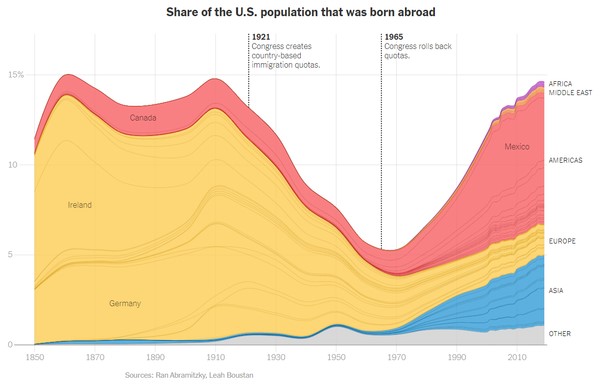Immigration at Near-Record Highs: A Net Positive for the US
Immigration has been a contentious issue in the United States since at least the 1840s when waves of Irish immigrants arrived to escape famine. Their arrival was met with racist backlash, and many were deported back to Ireland with little more than the clothes on their backs. Anti-immigrant sentiment shifted to anti-Chinese in the 1880s and anti-Italian in the 1920s. Despite the pro-immigration inscription on the Statue of Liberty, the U.S. has never been particularly welcoming to immigrants. This is despite the fact that 97% of Americans trace their ancestry to somewhere other than the U.S., and only 2.9% of Americans are of Native American descent.
Current Levels of Immigration
Immigrants comprise 13.6% of the total U.S. population, the highest since a record high of 14.8% in 1890. Anti-immigrant sentiment and policies from the 1920s through the 1960s slowed immigration, but it has been increasing steadily since then.

According to the U.S. Department of Homeland Security, the total number of legal immigrants admitted to the U.S. in fiscal year 2022 was 1,051,033. This is down from 1,210,069 in fiscal year 2021 but still represents a significant number of people coming to the U.S. each year. The number of detentions of migrants at the U.S.-Mexico border also remains near record highs.
Aging U.S. Population
The U.S. population is aging, and the birth rate is declining. The number of non-Hispanic White Americans decreased in real numbers for the first time in U.S. history from 2010 to 2020. The reason for this is simple. The non-Hispanic White population in the U.S. is, on average, 44.5 years old, and they are not having enough children to offset natural decline. The average age of newly arrived legal and undocumented immigrants is approximately 31 years old, and they are more likely to have children. Without immigration and the U.S.-born children of immigrants, the population of the United States would be shrinking.
Benefits of Immigration for the Economy
A study by the National Academies of Sciences, Engineering, and Medicine found that immigrants positively impact the U.S. economy. Immigrants are motivated to be self-sufficient and often come to the U.S. for job opportunities, filling gaps in the labor market, especially in sectors that face labor shortages.
Immigrants also have a history of contributing to American entrepreneurship. They are more likely to start businesses, creating jobs and stimulating economic development. High-profile companies like Google, Apple, and Tesla were founded by immigrants or the children of immigrants, showcasing the innovation and drive that immigrants can bring to the American economy.
Public Services
Immigrants, whether documented or undocumented, pay taxes in various forms, including income, property, and sales taxes. These tax contributions bolster government revenue, helping to fund essential public services, such as education, healthcare, and infrastructure. The overall youthfulness of immigrants also decreases their healthcare costs. Public services used by recently arrived immigrants are paid for by the tax contributions of working immigrants and second-generation immigrants, who are among the strongest fiscal and economic contributors in the U.S. Furthermore, studies have shown that immigrants use public services at lower rates than native-born citizens.
While Baby Boomers and the Silent Generation are the least likely to support immigration, they have immigrants to thank for maintaining the Social Security and Medicare trust funds with their payroll taxes.
Culture & Innovation
American culture is immigrant culture. Everything from apple pie and coffee to hot dogs and beer was brought to the U.S. by immigrants. In addition to their culinary contributions, immigrants have profoundly influenced Hollywood, music and the fine arts. This enriched American culture stimulates innovation. A study found that “technology areas (in the U.S.) with higher levels of foreign-born expertise experienced much faster patent growth between 1940 and 2000, in terms of both quality and quantity, than otherwise equivalent technology areas.” The space program (German rocket scientists), the internet (Nigerian refugee Philip Emeagwali, who created a formula that allowed a large number of computers to communicate at once) and a myriad of innovations in other industries were made possible by immigrants.
Conclusion
The U.S. has successfully integrated immigrants into society since its founding, despite the objections of isolationists. Over time, immigrants and their descendants have become integral to the American economy by boosting the labor force, starting businesses, paying taxes and raising families. Evidence suggests that a more welcoming and inclusive approach to immigration can be a powerful force for progress and prosperity.
In addition to the economic and demographic benefits, immigration makes the U.S. qualitatively and quantitatively a better, more vibrant, and dynamic place to live, with new ideas, perspectives, and traditions enriching our culture.